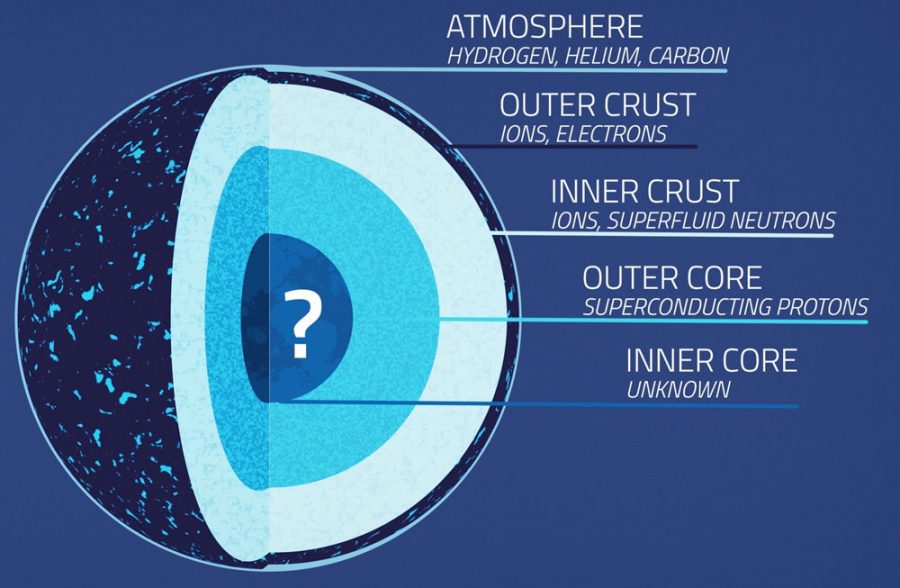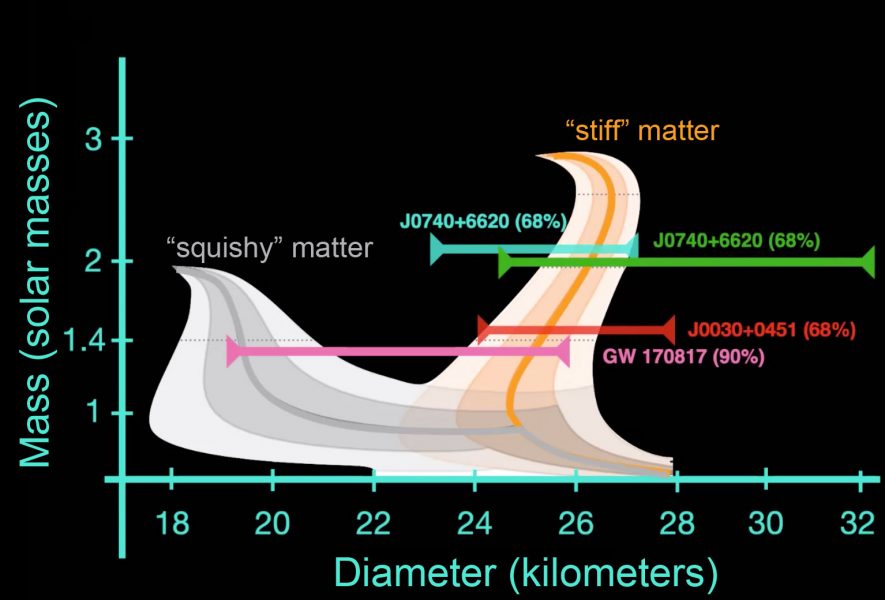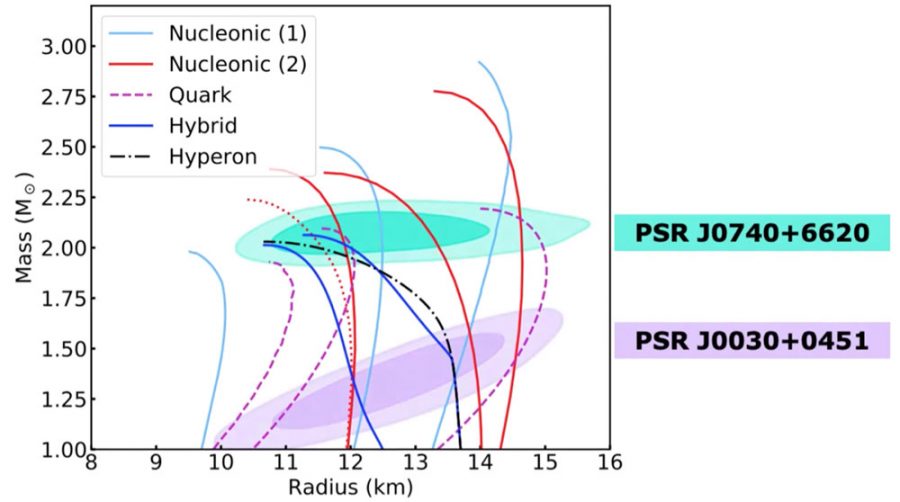Size measurements of two neutron stars are narrowing down what kinds of exotic matter might exist in their extremely dense cores.
Neutron stars are the tricksters of the celestial sphere. Their age, their temperature, even their size is not always what it first appears to be.
But with the Neutron star Interior Composition Explorer (NICER) aboard the International Space Station, astronomers are finally beginning to make some headway measuring these stars’ actual size — and with that, some insight into their strange interiors.
Members of the NICER team presented two independent size measurements of the most massive neutron star known at the recent virtual meeting of the American Physical Society. These studies, now undergoing scientific review, suggest that nuclear physicists might need to rethink what happens in the stars’ ultra-dense cores.
Matter at Its Most Extreme
Neutron stars are the cinders left when massive stars implode, shedding their outer layers in supernova explosions. The stars are poised on the edge, just this side of collapsing into a black hole, and the immense gravitational pressure squeezes their electrons and protons into neutrons. Lifting a teaspoon of this matter would be a feat similar to drinking empty a horn attached to the ocean — even Thor could not lift 4 billion tons.
However, there’s more to neutron stars than what’s in their name — they’re at most 95% neutrons and possibly even less. Their crystalline crusts contain relatively ordinary electrons and ions (the latter of which are made of neutrons and protons). As gravitational pressure increases with depth, the neutrons squeeze out of the nuclei, which eventually dissolve completely. Most protons merge with electrons; only a smattering remain for stability.

NASA’s Goddard Space Flight Center / Conceptual Image Lab
Deeper still, in the core, the density reaches something like twice that of an atomic nucleus. Here, the matter may transform again, releasing even the quarks that make up neutrons.
Or that’s what some theories say. But in fact nuclear physicists offer many answers to the riddle of neutron star interiors. “We have a theory for how quarks and gluons behave; this is quantum chromodynamics,” Miller says. “But the problem is you can't really calculate this once you go past a couple of particles.” So nuclear physicists use approximations and assumptions to predict the behavior of lots of particles — and they come up with a variety of answers.
To tell which idea is right, astronomers must do something deceptively simple: measure these objects’ mass and radius. From there they can use well-understood physics to calculate how pressure changes with density, a relation known as the equation of state, and then compare that equation to the nuclear physicists’ offerings.
Neutrons, Quarks, or Hyperons?
Obtaining the mass of a neutron star is easy, at least if the neutron star has a stellar companion whirling around it. But measuring size is trickier. Neutron stars’ gravity is so extreme, it bends the path of light leaving the surface. Like a funhouse mirror, this gravitational distortion makes the neutron star appear bigger than it really is.

NASA’s Goddard Space Flight Center / Chris Smith (USRA / GESTAR)
Anna Watts (University of Amsterdam) and Cole Miller (University of Maryland) lead two independent teams that analyze NICER data to see through this light-bending effect and put a ruler to neutron stars.
NICER is designed to measure the rapidly changing brightness of neutron stars as they whirl around. Some of these city-size objects spin faster than the blades in a kitchen blender, but NICER can catch changes over time periods as short as 100 nanoseconds. Additional observations by the European Space Agency's XMM-Newton telescope helped the teams understand the X-ray background and obtain more accurate results.
The X-ray emission NICER picks up comes primarily from hotspots at the base of the neutron star’s magnetic poles, where spiraling particles crash into the surface. Right away, it became clear that the magnetic field is complex. The hotspots are on the same hemisphere for both J0030 and J0740, which means that these neutron stars do not have perfect "bar magnet" dipole fields.

NASA's Goddard Space Flight Center
Watts’ and Miller’s teams have now analyzed hotspots on two neutron stars, mapping their locations and shapes as they whirl around. The first one, designated J0030+0451, is a lightweight at 1.4 times the mass of the Sun, with barely the heft to collapse into a neutron star rather than a white dwarf. Results for this object were published in 2019. The second, J0470+6620, is in the heavyweight class with 2.1 solar masses.
There are some slight differences between the teams’ analyses, but the end result is the same: Neutron stars are generally larger than scientists thought they might be.
“Our new measurements of J0740 show that even though it’s almost 50% more massive than J0030, it’s essentially the same size,” Watts says. “That challenges some of the more squeezable models of neutron star cores, including versions where the interior is just a sea of quarks.”

Sanjay Redding / APS meeting
Yet even as quark soup cores are ruled out, the larger size also suggests that the pressure in the core is more intense than previously realized. Whatever’s in the core has to stand up to that pressure, and that also appears to rule out simpler neutron cores. Some hybrid scenarios incorporating neutrons and quarks might work.
There’s another option too: Neutron star cores might contain something more massive than neutrons: a type of particle known as a hyperon. There are several particles classified as hyperons, and each one incorporates strange quarks. (Neutrons and protons have only up and down quarks.) Hyperons thus have some “strange” properties compared to neutrons and protons. Though they’ve been detected in particle accelerators, they’re unstable and decay quickly — but in neutron star cores, they might be stable enough to stick around for awhile.
“Our fervent hope is that at least we're able to make a lot of nuclear physicists sweat, because [the NICER result] is not easy to get into their models,” Miller says.

Anna Watts / APS meeting
Zaven Arzoumanian (NASA Goddard Space Flight Center), the deputy principal investigator and science lead of the NICER mission, says there’s more to come.
“We have a handful of additional pulsars that NICER is targeting,” he says. “We have collected a significant amount of data already for all of them, and we are analyzing them mostly in turn as we go.” Each additional mass and radius measurement will continue to narrow down the possibilities for what’s really inside neutron star cores.
 1
1









Comments
Dobsonite
May 22, 2021 at 12:32 am
Incredibly fascinating, but how much happier, wiser, and better are we for it?
I've had the "Abstract Research" meme in front of me all my life, and agree with it's value, but we have some real bad problems outside the halls of the ISS, Academe and Science to fix right now. Not later, NOW.
Can we use any of this newly gained knowledge to get a decent Fusion Reactor on-line any sooner than 20 years, etc, etc.
We need some real world, applicable-now results, not just the answering of abstract physics questions that demand more than "More studies [read: grants for academe salaries] are needed."
Sorry, but I'm very old, and the "Oooh-Ah" factor is beginning to pale beside some very real-world pressing issues. For instance, we need a cheap energy source breakthrough NOW, or there's not going to be anyone left on THIS planet to give a quark, or beg for more grants.
You must be logged in to post a comment.
You must be logged in to post a comment.